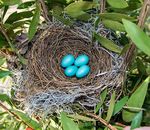Friends of Nylsvley and Nyl floodplain
←
→
Page content transcription
If your browser does not render page correctly, please read the page content below
Friends of Nylsvley and Nyl floodplain Since 1991
Newsflash
June 2020
Dear Friends,
SA is getting a back to normal but infections and deaths from Corvid 19 are increasing, not out of the
woods yet, best wishes as you continue to practice social distancing.
One of the features at the reserve frequently mentioned by Mr Whitehouse, senior (previous owner of the
farm Nylsvley) was that they would have a ‘year of’, a season when they saw lots of snakes (even on the
house) and another year hyaena etc. One of the iconic calls in the acacia areas and broad -leafed
woodlands is the Arrow-marked Babblers, one of the noisier species of birds. They live in groups of up to
15 and squabble loudly with groups in neighbouring territories. They have the most incredible blue eggs.
I choose a pic from Dr Warwick Tarboton’s collection of them huddling together as they must be doing
this winter! The Southern-pied Babblers are on the bird list but not seen so frequently. This year on our
property in Irene we have had an invasion of Arrow-marked Babbles, last season it was Bulbuls.
With thanks to Johan Marais of the African Snakebite Institute I have just learnt a new word: Brumation: Prior to
winter, there is a peak in snake activity. Snakes are feeding up, building fat reserves and searching for a suitable hideout
for the cold. Active hunters such as cobras and Boomslang will be on the move in search of prey. This means that they
often end up in human settlements and there is inevitably human-snake conflict. Many snakes have a retreat that they
will use every year if not disturbed. We have heard of Boomslang hiding out in the roof of old farmhouses, returning
every winter. Dr Tony Phelps recorded multiple Cape Cobras sharing the same den year after year in De Hoop Nature
Reserve. Many of the smaller snakes utilise old termite mounds for the winter, as they provide safety from predators and
get nice and warm in the afternoon sun, allowing the snakes inside to warm up. Most snakes seem to go underground.
The temperature underground may not be much warmer than the surface, but it is far more consistent. For many cold-
blooded animals (ectotherms) that rely on the environment to control their body temperature, cold temperatures don’t
necessarily kill them, but a drastic fluctuation in temperature
will. By hiding out underground, the snakes can retain a
constant body temperature. Many people refer to this period of
inactivity as hibernation. Hibernation technically refers to
warm-blooded animals (endotherms) and refers to the shutdown
of their metabolism and other systems to allow them to sleep off
the cold winters. For reptiles and other cold-blooded animals,
the term brumation has been used. It is very similar to
hibernation except that on a warm winter day, the increased
temperatures will allow reptiles to come out of their holes or
hiding spots and bask in the sun. They therefore break their
“hibernation” period based on external temperatures. This is
what differs between hibernation and brumation.
Pangolin are on the mammal list for Nylsvley, I do not know if any have been seen in recent years but
here is a bit of good news lifted from ‘Legalbrief Environmental, supplied by the Wildlife and
Environment Society to whom Friends of Nylsvley are affiliated.
General: China delists pangolin scales as a traditional medicine
Pangolin scales have been removed from an official 2020 listing of ingredients approved for use in traditional Chinese
medicine in a move lauded by animal protection groups as a key step in stamping out trade in the scaly
anteater, the world’s most trafficked mammal. According to a report in The Guardian, as many as 200 000
pangolins are consumed each year in Asia for their scales and meat and more than 130 tons of scales, live and dead
animals were seized in cross-border trafficking busts last year, a figure estimated to represent up to 400 000 animals,
according to conservation group WildAid. Trade in all eight species of pangolin are protected under international law
and three of the four native to Asia are included on the red list of the International Union for Conservation of Nature
as critically endangered species, including the functionally extinct Chinese pangolin. The news of the delisting from thetraditional Chinese medicine (TCM) pharmacopoeia, reported by China’s Health Times newspaper, comes after the
country’s State Forestry and Grassland Administration (SFGA) raised the protected status of pangolins to the highest
level last month, with immediate effect. Pangolins – which are notoriously difficult to breed in captivity – have been in
the spotlight since the start of the Covid-19 outbreak, due to studies suggesting they may have been the intermediate
host that transmitted the virus to humans.
Even 5 year olds get can sense the peace of the bush as Astri Leroy relates: We had a wonderful time
there 2 Easters ago when little Ashley Leroy was only 5, she threw a spectacular tantrum when we said
that it was time to pack up and go home, "I want to stay here
FOREVER!". My son Marc, his wife and little daughter Ashley
have been nagging us to camp at Nylsvley as soon as it is open
again for camping! I will let you know as soon as I hear, Marion.
Member Chris Williams remembers many many years ago being at
Nylsvley over Christmas and New Year with the then girlfriend
when there were no other visitors and no staff, imagine the peace?
Nylsvley has been a nature reserve since 1974 and was a private
Nature Reserve for 7 years before that (53 years).
Thanks to those Friends who have deposited their membership payments your contribution is vital as this
is presently our only source of income.
It will still be a while before we are able to use the Nylsvley facilities.
I have had the opportunity to look at the Nylsvley heritage assessment and found out that there are two
graveyards on the farm one of which has a neglected fence round it. Does anyone know where they are?
With best wishes Marion x x x
We thank Syd Catton for sending on these pics of the Nyl floodplain reminding us of what we are helping
to look after:You can also read
























































